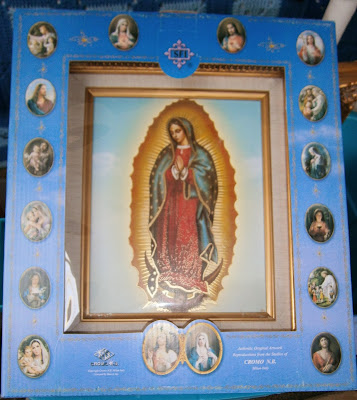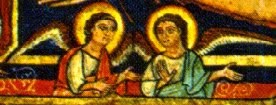 |
| Soft Saint Doll of Our Lady of Guadalupe |
You will recall that the Blessed Mother appeared to Saint Juan Diego in Mexico on December 12, 1531, at Tepeyac Hill near Mexico City, the site of a former pagan temple. She told him of her love for the Mexican people and asked the bishop to build a church in honor of her on the hill. When the bishop asked for proof of the apparition, the Blessed Mother appeared to Juan Diego, asked him to pick some roses which were miraculously in bloom, and bring them to her. This he did while she arranged them in his tilma (cloak). She told him to bring these to the bishop as a sign of the legitimacy of the apparition and of the sincerity of her request to build a church. When Juan Diego opened his cloak, the roses tumbled out and the image of the Virgin appeared on the tilma. The tilma is still preserved, and experts cannot explain how the image came to be there. It is imprinted into the fibers, in color. It is not painted onto the tilma.
 |
| Soft Saint Doll of Juan Diego |
The words of the Blessed Virgin of Guadalupe (which means She Who Crushes the Stone Serpent, an Aztec God) to Juan Diego, are as follows (not necessarily in the order spoken):
"Juanito, dearest Juan Diego."
"Listen, Juan, my dearest and youngest son, where are you going?"
 |
| Gold Framed and Accented Image of Our Lady of Guadalupe |
"Listen to me, my youngest and dearest son, know for sure that I do not lack servants and messengers to whom I can give the task of carrying out my words, who will carry out my will. But it is very necessary that you plead my cause and, with your help and through your mediation, that my will be fulfilled. My youngest and dearest son, I urge and firmly order you to go to the bishop again tomorrow. Tell him in my name and make him fully understand my intention that he start work on the chapel I'm requesting. Tell him again that I am the ever Virgin, Holy Mary, the Mother of God, who is sending you."
"That is fine, my youngest and dearest son; you will return here tomorrow so that you may take the sign he asked for. Then, he will believe and no longer doubt or be suspicious of you; and know, my dear son, I shall reward your care, work and fatigue in my behalf. Go now; tomorrow I shall be here waiting for you."
"What is happening, dearest and youngest of my sons? Where are you going? Where are you headed?"
"Listen, put it into your heart, my youngest and dearest son, that the thing that disturbs you, the thing that afflicts you, is nothing. Do not let your countenance, your heart be disturbed. Do not fear this sickness of your uncle or any other sickness, nor anything that is sharp or hurtful. Am I not here, I, who am your Mother? Are you not under my shadow and protection? Am I not the source of your joy? Are you not in the hollow of my mantle, in the crossing of my arms? Do you need anything more? Let nothing else worry you, disturb you. Do not let your uncle's illness worry you, because he will not die now. You may be certain that he is already well."
"Go up, my dearest son, to the top of the hill, to where you saw me and received my directions and you will find different kinds of flowers. Cut them, gather them, put them all together, then come down here and bring them before me."
"My youngest and dearest son, these different kinds of flowers are the proof, the sign that you will take to the Bishop. You will tell him from me that he is to see in them my desire, and therefore he is to carry out my wish, my will. And you, who are my messenger, in you I place my absolute trust. I strictly order you not to unfold your tilma or reveal its contents until you are in his presence. You will relate to him everything very carefully: how I sent you to the top of the hill to cut and gather flowers, all you saw and marveled at in order to convince the Governing Priest so that he will then do what lies within his responsibility so that my house of God which I requested will be made, will be built."
Source: Br. Francis Mary, "Nican Mopohua: Original Account of Guadalupe," in A Handbook on Guadalupe.
The CFP Holy Angels Gift Shop has several items honoring Our Lady of Guadalupe. These include medals, prayer cards, Conception is Life Rosary, Soft Saint Dolls, a Rosary CD, and book.
 |
| Framed image of Our Lady of Guadalupe as the image appeared on the tilma of Juan Diego |
"Am I not here, I, who am your Mother? Are you not under my shadow and protection? Am I not the source of your joy? Are you not in the hollow of my mantle, in the crossing of my arms? Do you need anything more? Let nothing else worry you, disturb you."





